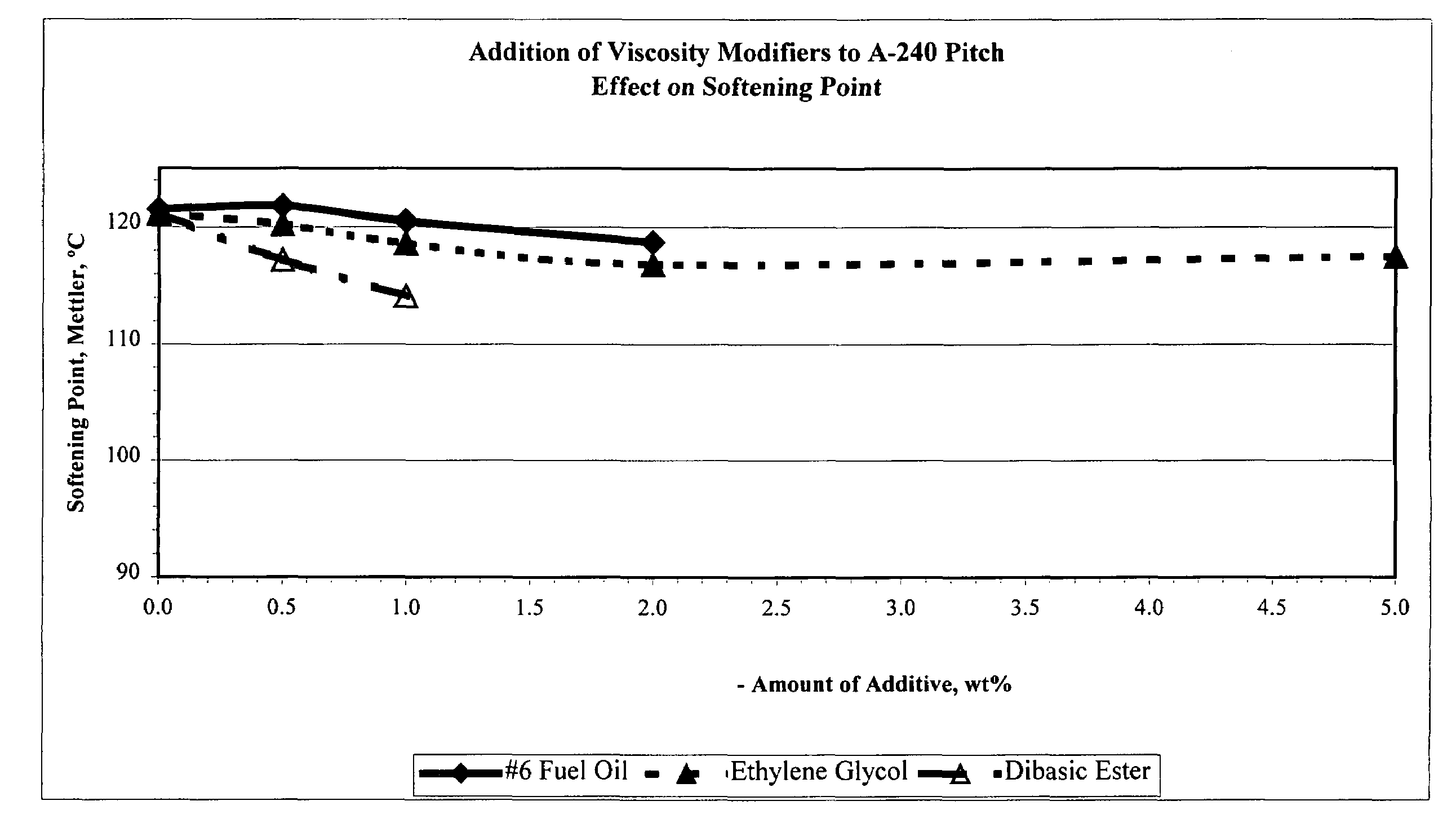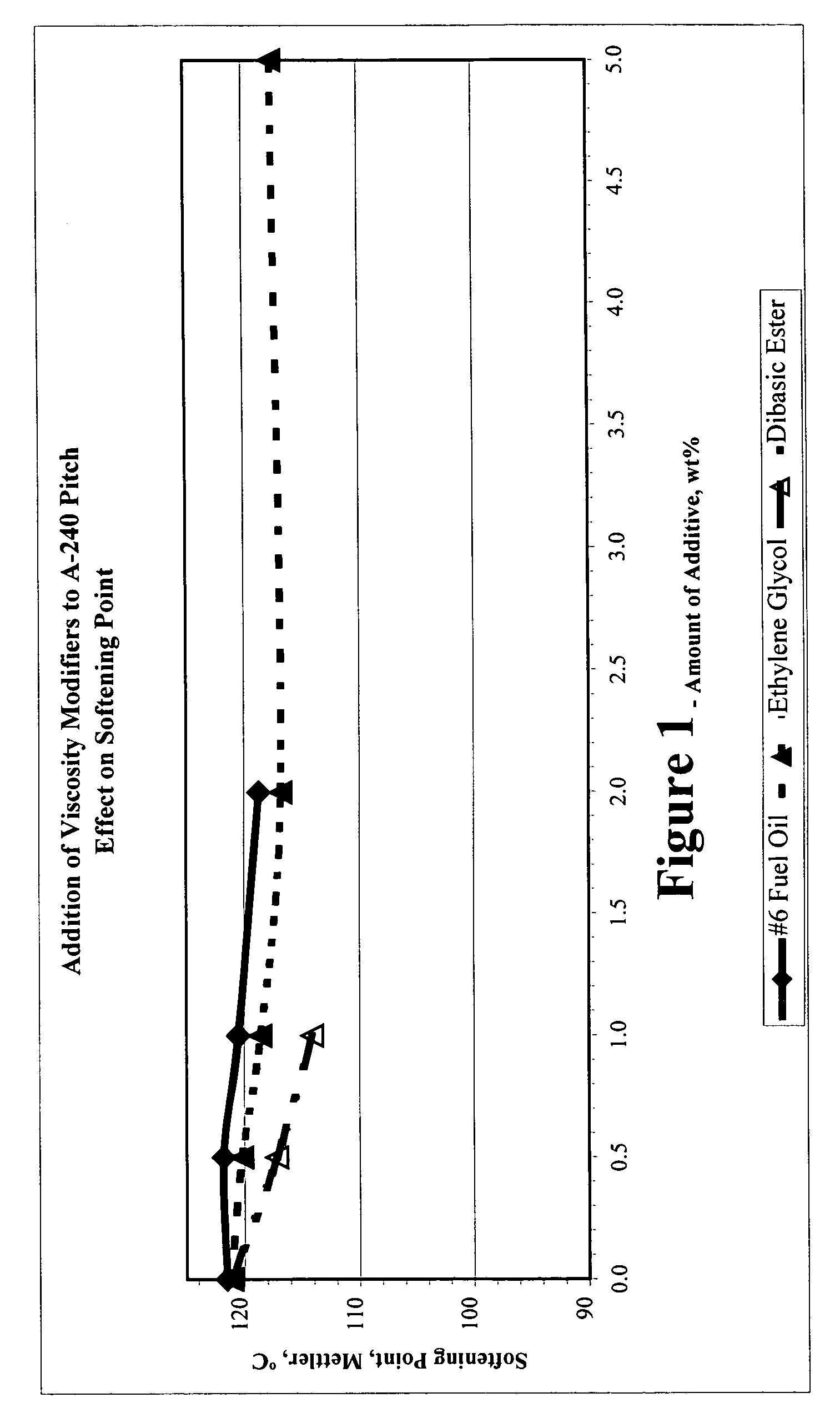Viscosity modification of heavy hydrocarbons using dihydric alcohols
a technology of dihydric alcohol and viscosity modification, which is applied in the direction of tar working up by chemical refining, mechanical equipment, transportation and packaging, etc. it can solve the problems of high cost of dibasic esters, limited applicability, and insufficient viscosity modification of dibasic esters, so as to reduce the carcinogenicity of pitch products, reduce the carcinogenic level, and reduce the viscosity and/or softening point
Inactive Publication Date: 2006-08-22
MARATHON PETROLEUM
View PDF21 Cites 0 Cited by
- Summary
- Abstract
- Description
- Claims
- Application Information
AI Technical Summary
Benefits of technology
[0016]In one aspect, the present invention relates to a method of reducing the viscosity of heavy hydrocarbon materials. According to one aspect of the present invention, the heavy hydrocarbon material is heated to produce a molten material. A viscosity reducing amount of at least one dihydric alcohol such as ethylene glycol is dissolved in the molten material. In certain embodiments, the starting heavy hydrocarbon material has a softening point above about 100° C. Also, in preferred embodiments, from about 0.5 to about 5%, and in certain embodiments to about 2%, by weight, of the dihydric alcohol is dissolved in the heavy hydrocarbon material.
[0018]In another aspect, the present invention relates to a low viscosity, high softening point, heavy hydrocarbon material having a relatively high softening point and a relatively high viscosity having a suitable amount of at least one dihydric alcohol dissolved in the heavy hydrocarbon material.
[0020]Yet another aspect of the present invention relates to a method of reducing carcinogenicity of a pitch product made from a starter pitch. The starter pitch comprises a distillable carcinogenic fraction and a higher boiling point, or non-distillable, pitch fraction having a reduced carcinogen level and an unacceptable high viscosity and / or softening point. The method includes distilling from the starter pitch at least a portion of the distillable carcinogen fraction to produce a reduce carcinogen pitch fraction that has an unacceptable high molten viscosity. The viscosity of the reduced carcinogen pitch fraction is then reduced by dissolving therein a viscosity reducing amount of at least one dihydric alcohol. The product is a low carcinogen pitch product having an acceptable molten viscosity.
Problems solved by technology
However, the use of these solvent “cutback” materials often causes problems with flash point and volatility if too much solvent is used.
However, the dibasic esters are expensive and are limited in their applicability to less viscous coal tars.
Also, the dibasic esters do not adequately modify the viscosity of more viscous pitches such as petroleum pitches.
Method used
the structure of the environmentally friendly knitted fabric provided by the present invention; figure 2 Flow chart of the yarn wrapping machine for environmentally friendly knitted fabrics and storage devices; image 3 Is the parameter map of the yarn covering machine
View moreImage
Smart Image Click on the blue labels to locate them in the text.
Smart ImageViewing Examples
Examples
Experimental program
Comparison scheme
Effect test
example i
[0047]The ability of the dihydric alcohol to desirably reduce the softening point of A-240 petroleum pitch compared to No. 6 fuel oil, and diabasic esters and ethylene glycol is shown in FIG. 1.
the structure of the environmentally friendly knitted fabric provided by the present invention; figure 2 Flow chart of the yarn wrapping machine for environmentally friendly knitted fabrics and storage devices; image 3 Is the parameter map of the yarn covering machine
Login to View More PUM
| Property | Measurement | Unit |
|---|---|---|
| softening point | aaaaa | aaaaa |
| softening point | aaaaa | aaaaa |
| wt % | aaaaa | aaaaa |
Login to View More
Abstract
A low viscosity, high softening point heavy hydrocarbon material having a viscosity reducing amount of at least one dihydric alcohol dissolved therein, and a method for producing such heavy hydrocarbon material, are disclosed.
Description
FIELD OF THE INVENTION[0001]The present invention relates to the use of dihydric alcohols such as ethylene glycol as viscosity modifiers for heavy hydrocarbons such as asphalt and pitch.BACKGROUND OF THE INVENTION[0002]Petroleum pitch competes with coal tar pitch in many applications where the pitch is used as a carbon source and / or as a binder. The critical properties that are evaluated when deciding what type of pitch to use include: (a) flow properties, as measured by softening point and / or viscosity, and (b) carbon yield, as measured by ASTM D 2488, Coking Value by Modified Conradson Carbon.[0003]Another pitch property that is also becoming of increasing interest is the polycyclic aromatic hydrocarbon (PAH) content. The U.S. Pat. No. 5,746,906 patent describes a coal tar pitch having a low polycyclic aromatic hydrocarbon content and a method of making such pitch where a high softening point coal tar pitch (softening point of 120–175° C.) was mixed with a low softening point petr...
Claims
the structure of the environmentally friendly knitted fabric provided by the present invention; figure 2 Flow chart of the yarn wrapping machine for environmentally friendly knitted fabrics and storage devices; image 3 Is the parameter map of the yarn covering machine
Login to View More Application Information
Patent Timeline
 Login to View More
Login to View More Patent Type & Authority Patents(United States)
IPC IPC(8): C10C3/00C10C1/00C01BC10C3/02
CPCC10C3/02C10C3/00Y10T137/0391
Inventor KISER, MELVIN D.
Owner MARATHON PETROLEUM
Features
- R&D
- Intellectual Property
- Life Sciences
- Materials
- Tech Scout
Why Patsnap Eureka
- Unparalleled Data Quality
- Higher Quality Content
- 60% Fewer Hallucinations
Social media
Patsnap Eureka Blog
Learn More Browse by: Latest US Patents, China's latest patents, Technical Efficacy Thesaurus, Application Domain, Technology Topic, Popular Technical Reports.
© 2025 PatSnap. All rights reserved.Legal|Privacy policy|Modern Slavery Act Transparency Statement|Sitemap|About US| Contact US: help@patsnap.com


